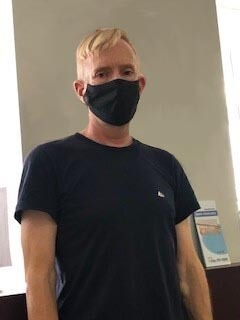I’ve lived with chronic musculoskeletal pain since December 2015. At its worst, sitting and walking were virtually impossible. Lack of mobility made my world very small – my bedroom – triggering situational depression. I obsessively researched my condition and constantly catastrophized, imagining the worst about treatment outcomes.
Fascial manipulation is one physical treatment that’s given me some relief. Physical activity (within limits) and motion also help. I took opioids. They relieved my pain more effectively than other treatments in the early days. I got on the treadmill of ever-increasing opioid doses and diminishing effectiveness, so eventually I had to wean myself off. I now use muscle relaxants for pain.

I used to be a lawyer. I currently volunteer at Craft Ontario in Toronto. To do so, I must rotate functions – standing, then sitting, then pacing and repeat – but it’s good to be giving back to the community. If my pain continues to lessen, I want to do part-time legal aid.
Why I give to Pain BC
Dr. Squire, a well-known pain specialist in Vancouver, was the first to say to me, “It’s not your fault.” That seems obvious, but at times you tend to think it is your fault. Dr. Squire told me about Pain BC’s programs, including Making Sense of Pain, a self-management class series. Up until then, I had focused on physical treatments to address the awful sensory experience that is pain.
Making Sense of Pain helped me understand that there is no silver bullet to pain management, and that several treatments are required, from pharmaceutical to physical to psychological. Afterwards, I looked into Cognitive Behavioural Therapy; I applied a structured form called Dynamic Neural Retraining System (DNRS) for 9 months. DNRS didn’t reduce my pain, but it helped with how I thought about pain. For the first time, I looked at things in a balanced way and stopped catastrophizing. My depression was alleviated such that I didn’t have to take anti-depressants. When I thought about that experience, it was an easy thing for me to start donating to Pain BC. That program changed the way I looked at pain.
The other thing Pain BC did for me was help me understand the stigma surrounding chronic pain. I experienced negative judgments from some family members who questioned and minimized my pain because it’s invisible. Pain BC taught me that I don’t have to convince anybody of my pain, except health care professionals (HCPs). I was grateful for that insight.
I’d like to share this quote with people living with chronic pain: “There are three things that do not define you: Your past, their judgment, and your lowest moments.”
How I interacted with my long-term disability provider
In some ways I was an exceptional case. Imaging, such as ultrasound, consistently showed tissue damage corresponding with where my pain is located. I was thus able to show my long-term disability (LTD) provider that my pain had known causes. I understand that often there is no clear explanation for chronic pain.
I hope this can assist people living with persistent pain when dealing with LTD providers:
- Build credibility: It is important to demonstrate you have sought medical attention from appropriate experts and implemented all HCP treatment recommendations. I found it beneficial to include in LTD reports written notes from HCPs confirming I implemented their recommendations.
- Be honest and thorough: I never exaggerated my pain. I offered to arrange calls between my LTD provider and HCPs. My LTD provider never took me up on this – but I wanted to show that I was transparent, and these offers went over well.
On navigating the Canadian health care system
This topic could fill a book. I share the following three points:
First, I was taken more seriously when I knew something about my condition. It’s important to find a balance, as you can go down a rabbit hole with research, and it can end up reinforcing catastrophizing. So, after I learned enough to be able to talk about my condition, I focused my research on treatments. It was a more positive experience.
Second, knowing when to visit the Emergency Room (ER). When I learned it would be over a year until I saw a pain specialist, I went to Vancouver General Hospital ER looking to speed up imaging and referrals. It was difficult because it ended up being a 12-hour wait, and this was at a time when my pain was uncontrolled. I got an MRI within three days; it showed serious left hip trauma that could have been overlooked by a physical exam. I did not go to ER multiple times as I knew from others’ experience there are diminishing returns after an initial visit.
Third, since it takes time to see a specialist, it’s important to have a General Practitioner (GP) with some pain experience, or at least a GP willing to learn and able to do injections. I ended up doing much of the coordination with other HCPs myself until my GP got up to speed.
Our gratitude to Craig for sharing his story and for his generous donation to Pain BC. Sharing stories contributes to combatting stigma and raising awareness of chronic pain.